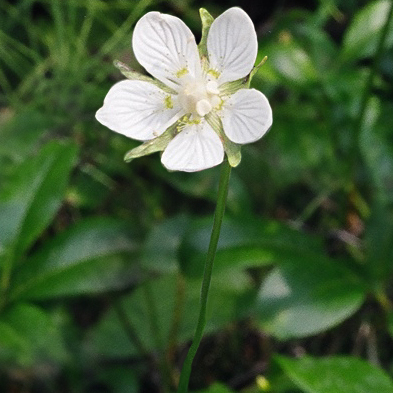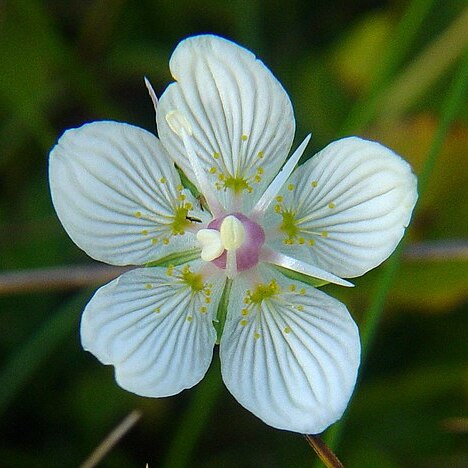Herbs, perennial <with caudices or rarely rhizomes>. Stems erect, unbranched <scapelike>. Leaves basal <in rosettes or 1–2 per node on rhizomes (P. caroliniana)> and cauline <(0–)1[–8]>, alternate; stipules absent; petiole present in basal leaves, usually absent in cauline leaf; blade margins entire; venation palmate. Inflorescences terminal, flowers solitary. Flowers bisexual, radially symmetric or ± asymmetric; perianth and androecium hypogynous or perigynous; hypanthium absent or completely adnate to ovary; sepals 5, connate proximally; petals 5, white [yellowish] with distinct yellowish or greenish or gray-brown veins, <3–22 mm, usually longer than sepals>; nectary absent; stamens 5; staminodes 5, opposite petals, usually deeply divided, sometimes undivided, gland-tipped or glandular at apex [without glands]; pistil [3–]4[–5]-carpellate; ovary superior to 1/2 inferior, 1-locular, placentation parietal; style absent or essentially so; stigmas [3–]4[–5]; ovules 100–2000+. Fruits capsules, 1-locular, <[3–]4[–5]-valved>, ellipsoid to globose, apex not beaked. Seeds 100–2000+ per fruit, oblong, winged; aril absent. x = 9.
Fls perfect; hypanthium short; sep, pet, and stamens each 5; staminodia 5, opposite the pet, each consisting of 3 or more sterile stamens ± connate at base and separate above, their anthers reduced to glands; ovary superior or partly inferior, unilocular; ovules numerous on 4 parietal placentas; stigmas 4, nearly sessile, commissural; capsule 4-valved, loculicidal; seeds numerous, oblong, angular, cellular-reticulate; glabrous perennial herbs, the lvs entire, palmately veined, mostly long-petioled in a basal rosette, or a single sessile one on the erect, 1-fld scape; fls erect, the pet white, conspicuously veined. 50, N. Temp.


